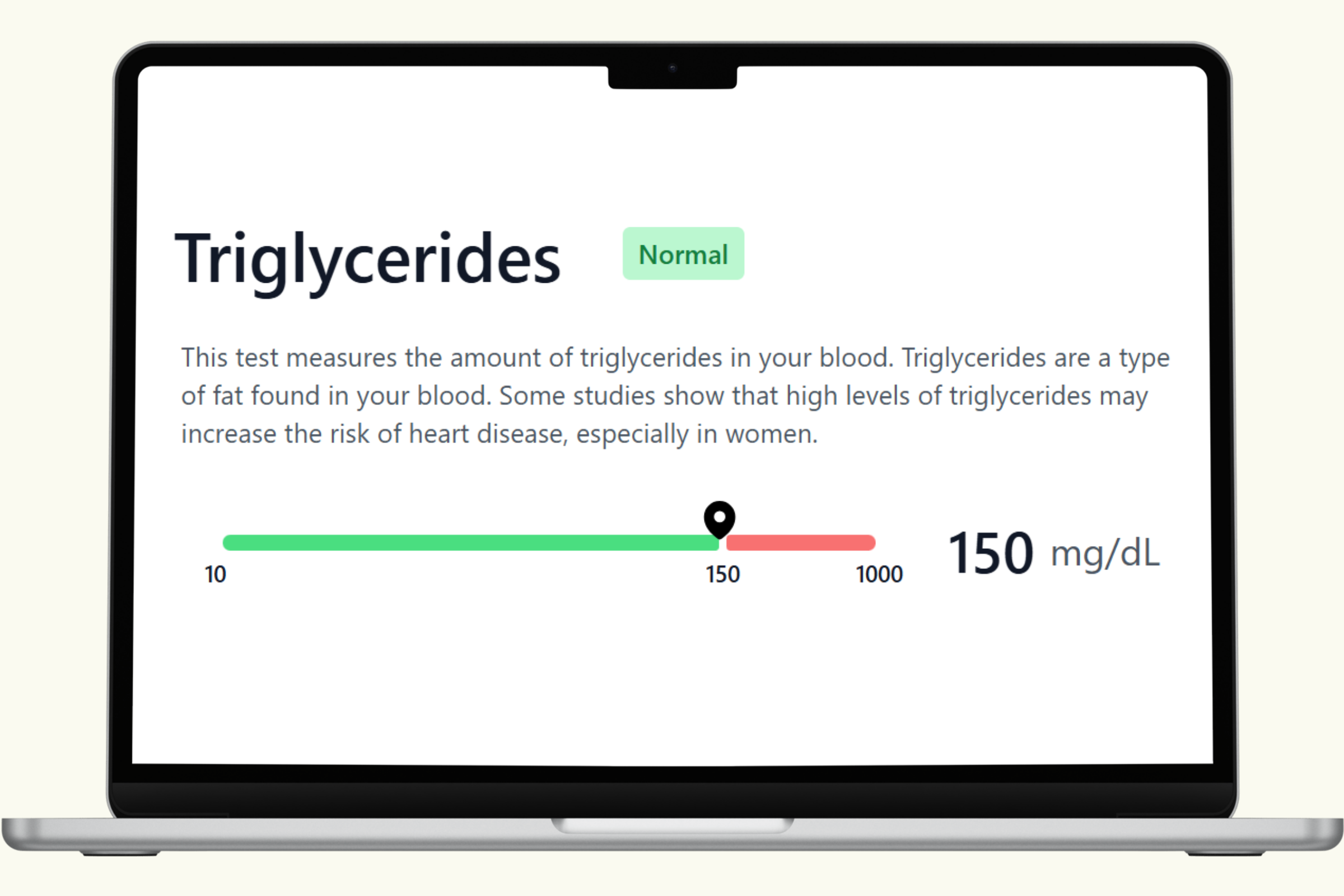Triglycerides Blood Test
The Triglycerides Blood Test measures the amount of fat circulating in your bloodstream. Triglycerides are the most common type of fat in the body and serve as an important energy source. After you eat, your body converts calories it doesn’t immediately need into triglycerides, storing them in fat cells for later use. While this process is normal, having too many triglycerides in your blood can increase the risk of serious health conditions, including heart disease, stroke, atherosclerosis, and pancreatitis.
As part of the PlexusDx Diabetes & Heart Health Blood Test, measuring triglycerides provides critical insight into your cardiovascular and metabolic health. With at-home dried blood spot (DBS) collection on an ADX card, you can easily monitor triglyceride levels without the need for a clinic visit.
What the Triglycerides Test Measures
This test measures the concentration of triglycerides in your blood, usually reported in milligrams per deciliter (mg/dL). Since triglycerides are directly influenced by food intake, doctors often recommend fasting before a test for the most accurate results. High triglyceride levels often occur alongside other lipid imbalances, such as high LDL cholesterol, low HDL cholesterol, and elevated VLDL cholesterol.
Why Triglycerides Matter
Elevated triglycerides are more than just a number on your lab report—they are a marker of metabolic imbalance and cardiovascular risk. Excess triglycerides can contribute to plaque buildup in arteries (atherosclerosis), leading to reduced blood flow and increased risk of heart attack and stroke. Extremely high triglyceride levels can also cause pancreatitis, a potentially life-threatening inflammation of the pancreas.
High triglycerides are commonly linked with:
- Obesity
- Type 2 diabetes and insulin resistance
- Poor diet high in refined carbs, sugars, and unhealthy fats
- Excessive alcohol consumption
- Genetics and family history of lipid disorders
- Metabolic syndrome
Reference and Functional Ranges
According to standard clinical guidelines, triglyceride levels are classified as follows:
- Normal: Below 150 mg/dL
- Borderline High: 150–199 mg/dL
- High: 200–499 mg/dL
- Very High: 500 mg/dL or above
In functional and preventive medicine, optimal triglyceride levels are typically considered below 100 mg/dL to reduce long-term risk of cardiovascular and metabolic diseases.
How the Test is Collected
The PlexusDx Diabetes & Heart Health Blood Test uses an at-home dried blood spot collection with an ADX card. A quick finger prick provides a few drops of blood, which you apply to the card and mail to the lab for analysis. This method is:
- Fast and convenient
- Clinically accurate
- Less invasive than a venous blood draw
- Ideal for regular monitoring of cardiovascular and metabolic health
Factors That Influence Triglyceride Levels
Several lifestyle and health factors directly affect triglyceride levels:
- Diet: High intake of refined carbs, sugars, and processed foods increases triglycerides.
- Exercise: Regular activity lowers triglycerides and improves lipid balance.
- Weight: Excess body fat raises triglycerides, while weight loss significantly reduces them.
- Alcohol: Even small amounts of alcohol can raise triglycerides in some people.
- Medical conditions: Diabetes, hypothyroidism, kidney disease, and liver disease can all elevate triglycerides.
- Medications: Certain drugs, including steroids, diuretics, and beta-blockers, may raise triglycerides.
How to Lower Triglycerides
The good news is that triglycerides respond strongly to lifestyle changes. Strategies to improve your levels include:
- Adopt a heart-healthy diet: Focus on whole grains, vegetables, fruits, lean proteins, and healthy fats such as omega-3s.
- Reduce refined carbs and added sugars: Limiting sweets, sugary drinks, and processed foods can significantly lower triglycerides.
- Exercise regularly: At least 150 minutes of moderate activity each week helps reduce triglycerides and improve HDL cholesterol.
- Maintain a healthy weight: Even a modest 5–10% weight loss can reduce triglycerides substantially.
- Limit alcohol: Some individuals see large improvements in triglycerides simply by reducing or eliminating alcohol.
- Medical therapy: In cases of very high triglycerides, medications such as fibrates, omega-3 fatty acid supplements, or statins may be recommended.
Why Pair Triglycerides with Other Biomarkers?
Triglycerides are an essential part of understanding heart and metabolic health, but they are most valuable when viewed alongside other lipid and glucose markers. The PlexusDx Diabetes & Heart Health Blood Test also measures cholesterol fractions (LDL, HDL, VLDL), cholesterol ratios, glucose, and hemoglobin A1C. Together, these results provide a comprehensive picture of your risk for cardiovascular disease and diabetes.
Take Charge of Your Cardiovascular Health
The Triglycerides Blood Test is a vital tool for identifying hidden risk factors and monitoring your progress over time. With PlexusDx’s simple at-home collection method, you can keep track of your heart and metabolic health without the inconvenience of traditional lab visits. By making informed lifestyle choices and using your results to guide personal health strategies, you can lower triglycerides, protect your heart, and support long-term wellness.

Share:
LDL Blood Test
VLDL Blood Test